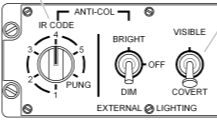On a clear night, everyone can spot planes quite easily: they have flashing lights. I have noticed that the pattern seems different for different planes, and tried to find a meaning.
What I saw so far is that they seem to have three lights that flash, two at the wings, one at the tail. Those at the wings flash two times (approximately per second, in quick succession), and that one at the tail flashes only once, along with the first flash of the wing.
Now that explains two patterns I seem to see from further away: Two flashes and one flash. It is probably that I am just not seeing the wings flashing for those where I only see one.
So far so good, but then again sometimes I see planes with more flashing, and those are faster. I had difficulties to count them, but it's at least three, maybe four quick flashes.
Do these different patterns have any meaning? I tried to match up the planes with the flight radar information, but since it is quite crowded around here, I wasn't really able to identify them. But whenever I saw that quick flashing ones, there was a military plane around, is that just coincidence?


